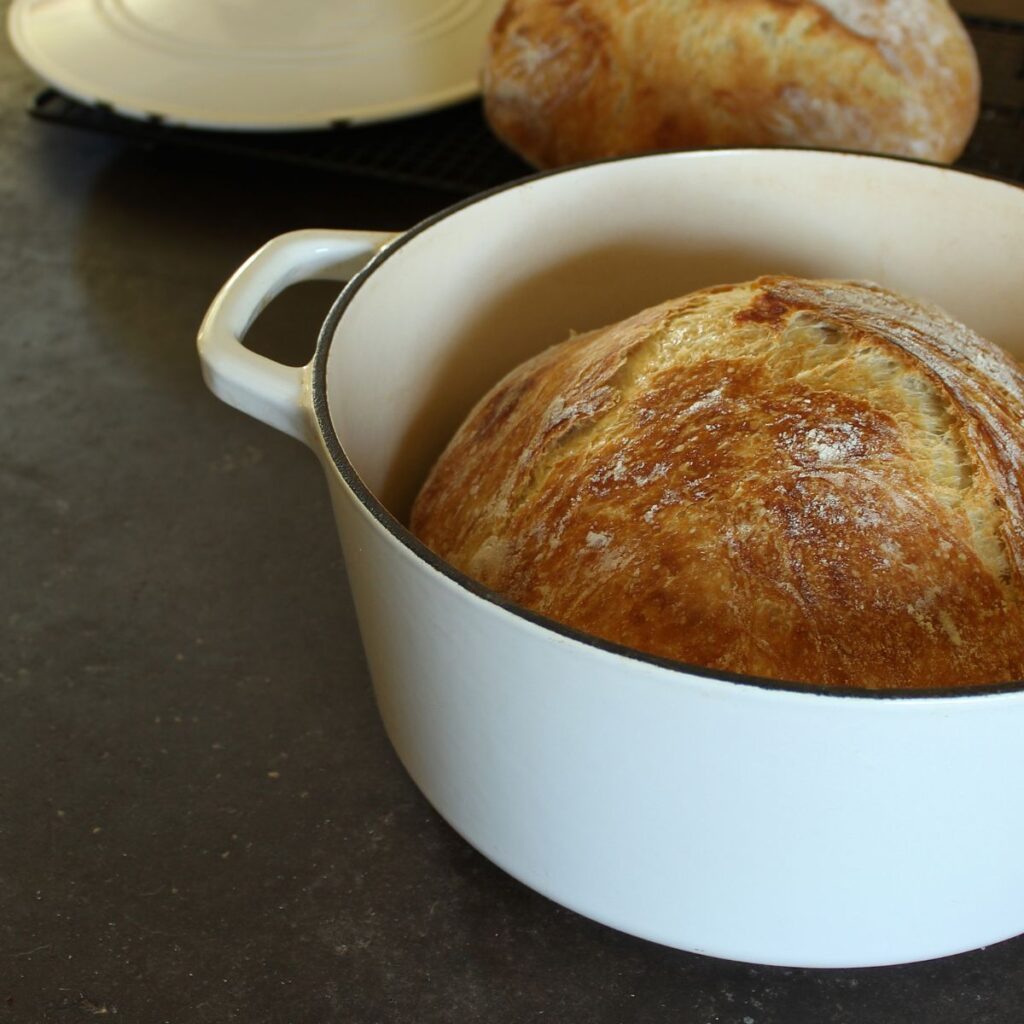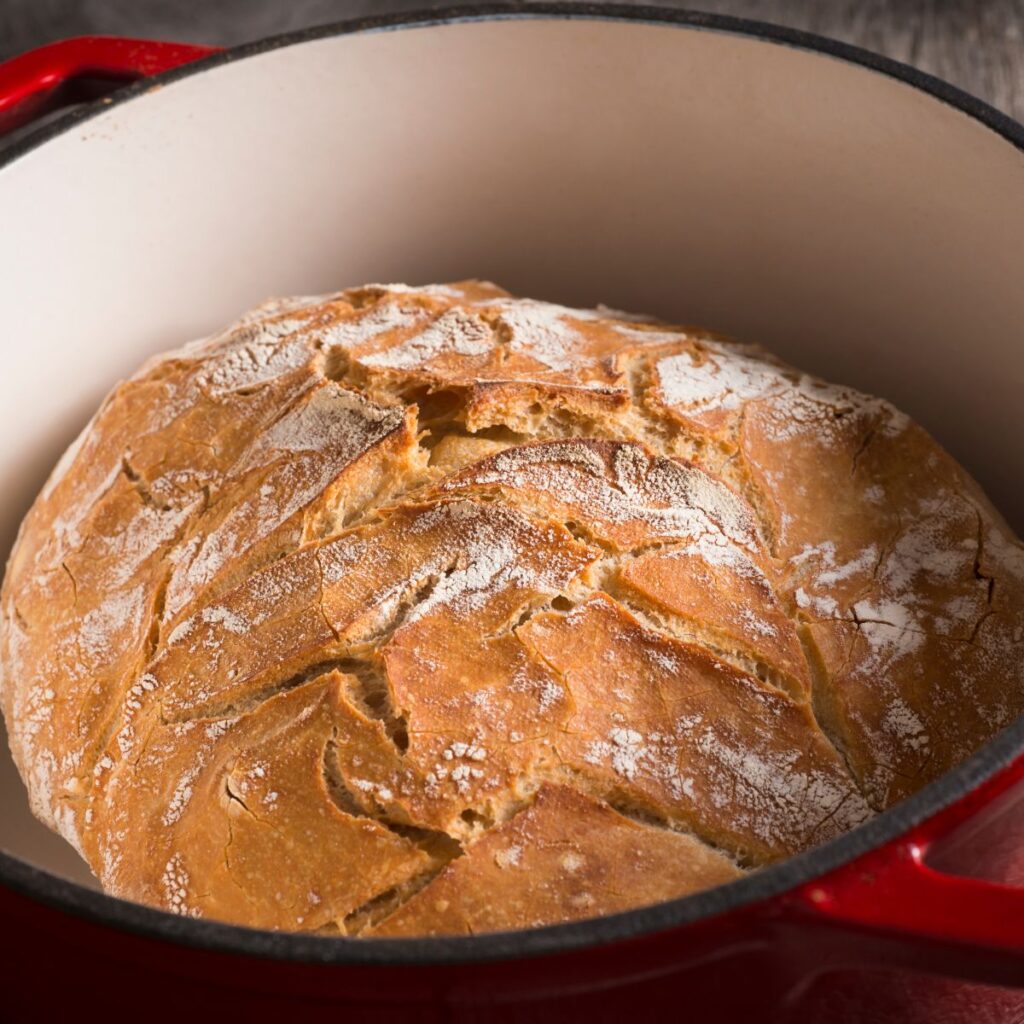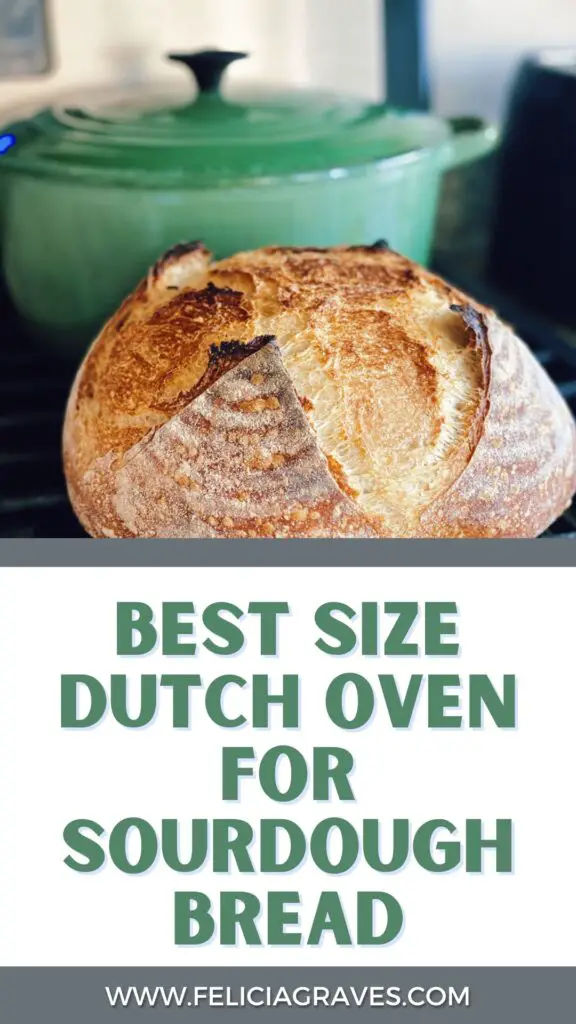Are you a home baker seeking to achieve the perfect loaf of sourdough bread? When it comes to baking artisanal bread with a crispy crust and a soft, airy interior, the Dutch oven is an indispensable tool. In this blog post, we will explore the best size Dutch oven for baking sourdough bread and share some valuable insights to help you achieve bakery-quality results in the comfort of your own kitchen.

Discloser Note:
This post may contain affiliate links, which means I make a small commission at no extra cost to you. See my full disclosure here.
Why the Dutch Oven?
The Dutch oven’s unique design and construction make it an ideal choice for bread baking. Its thick walls and heavy lid retain heat, creating the perfect environment for baking bread. The Dutch oven excels at trapping steam, which is crucial for achieving that coveted crispy crust. Additionally, its versatility allows it to be used for various cooking techniques, from stovetop braising to oven roasting. If you are determined to make sourdough bread without a dutch oven it can be done however, when it comes to bread baking, the Dutch oven truly shines.
The Perfect Dutch Oven Size
When selecting a Dutch oven for baking sourdough bread, size does matter. The best Dutch oven size will depend on your bread recipe and personal preferences. However, there are a few key factors to consider. First and foremost, the Dutch oven should provide enough room for the dough to expand during baking. A tight-fitting lid is essential to trap steam and create the desired oven spring. Moreover, the Dutch oven should be able to withstand high temperatures without warping or compromising its performance.
For most home cooks, a 5 to 7-quart Dutch oven is an excellent choice. This size provides ample space for the dough to rise and expand while ensuring there is enough room for the steam to circulate. However, if you prefer baking smaller loaves or have limited storage space, a 3 to 4-quart Dutch oven can also yield good results. On the other hand, if you often bake larger loaves or want to experiment with different shapes, a 9 to 10-quart Dutch oven might be the right fit for you.
Personally, I have two 5 quart dutch ovens that I use for everything from baking sourdough bread to slow cooking roast, making stews, and even cooking whole chickens.

Types of Dutch Ovens
When it comes to selecting the best Dutch oven for sourdough bread baking, you have a few options to consider. The most popular types of Dutch ovens are bare cast iron, enameled cast iron, stainless steel, and ceramic. Each type has its advantages and considerations, so let’s delve into them:
Bare Cast Iron Dutch Oven: A classic choice, bare cast iron Dutch ovens are known for their exceptional heat retention and durability. They can withstand high temperatures and are perfect for achieving a golden brown crust. However, they require seasoning and proper care to prevent rusting.
Enameled Cast Iron Dutch Oven: Enameled Dutch ovens offer the benefits of cast iron with the added advantage of a non-reactive and easy-to-clean enamel coating. They come in various colors and sizes, with Le Creuset Dutch ovens being among the top picks. Enameled cast iron Dutch ovens are excellent for baking sourdough bread due to their even heat distribution and heat retention properties.
Stainless Steel Dutch Oven: If you prefer a lightweight and low-maintenance option, stainless steel Dutch ovens are a great choice. They heat up quickly, making them suitable for bread baking. However, they may not provide the same heat retention as cast iron.
Ceramic Dutch Oven: Ceramic Dutch ovens offer a stylish alternative with excellent heat retention capabilities. They are perfect for home bakers who prioritize aesthetics without compromising functionality. However, they may be more fragile compared to other types of Dutch ovens.
No matter which type of Dutch oven you choose, make sure it has a tight-fitting lid and is oven-safe at high temperatures. The right Dutch oven will enhance your bread baking experience and help you achieve the perfect sourdough loaf.
Baking with the Dutch Oven
Now that you’ve selected the best Dutch oven for baking sourdough bread, let’s explore the best way to use it for optimum results. Here’s a step-by-step guide to help you through the process:
- Preheat your Dutch oven: Place your Dutch oven, with the lid on, in the oven and preheat it to the desired temperature. Most sourdough bread recipes recommend a high heat, typically around 450 degrees Fahrenheit (230 degrees Celsius).
- Shape and proof your dough: Once your dough has completed its bulk fermentation and dough rest, it’s time to shape it. Use a dough whisk or a silicone spatula to gently shape the dough into a round or oval shape. If using a proofing basket, line it with a piece of parchment paper, place the shaped dough seam side up, and cover it with a clean kitchen towel. Allow the dough to proof at room temperature until it has visibly expanded.
- Score the dough: Just before baking, carefully remove the preheated Dutch oven from the oven. Lift the proofed dough using the parchment paper and place it in the Dutch oven. Use a sharp knife or a razor blade to score the top of the dough. Scoring helps the bread expand during baking and adds a decorative touch.
- Bake with steam: Place the lid back on the Dutch oven and transfer it to the hot oven. The steam created inside the Dutch oven will help the bread rise and develop a crust. The high heat and steam will create a desirable oven spring, resulting in a light and airy crumb.
- Remove the lid and bake until golden brown: After a period of baking with the lid on, remove the lid to allow the crust to develop a beautiful golden brown color. Continue baking until the bread is fully cooked, typically for an additional 10 to 15 minutes.
- Cool and enjoy: Once baked, carefully remove the Dutch oven from the oven using oven mitts or pot holders. Lift the bread out of the Dutch oven and transfer it to a cooling rack to cool completely before slicing. This step is crucial for the bread to set and avoid a gummy texture.

Tips and Tricks for Baking Success
Here are a few additional tips and tricks to elevate your Dutch oven sourdough bread baking experience:
- Use a baking stone: Placing a baking stone in the oven while preheating the Dutch oven can enhance the oven spring and create a more even bake.
- Experiment with different types of flour: From bread flour to whole wheat flour, different types of flour can yield various flavors and textures. Feel free to explore and find your favorite combination.
- Consider higher hydration doughs: Higher hydration doughs (those with more water content) often result in more open and airy crumb structures. However, they may require adjustments to the baking time and temperature.
- Allow enough time for the dough to rest: Patience is key when it comes to sourdough bread baking. Allowing the dough to rest and rise properly will contribute to better flavor development and texture.
In the world of bread baking, the Dutch oven reigns supreme. Its ability to create the perfect environment for baking sourdough bread with a crispy crust and soft interior is unmatched. By choosing the right size Dutch oven and following the steps outlined in this blog post, you can achieve bakery-quality results in your very own kitchen. Whether you opt for a 5 to 7-quart Dutch oven or prefer to experiment with smaller or larger sizes, the Dutch oven’s versatility and heat retention properties will elevate your bread baking game. So, gather your ingredients, preheat your Dutch oven, and embark on a delightful journey of baking delicious, crusty sourdough loaves that will impress even the most discerning bread connoisseurs. Happy baking!
Frequently Asked Questions
Can I use a Dutch oven with enamel coatings for baking sourdough bread, or are bare cast iron Dutch ovens better suited?
answer
Are there any specific Dutch oven brands or models that are highly recommended for sourdough bread baking?
answer
Are there alternative methods or tools for achieving a crispy crust and soft interior if a Dutch oven is not available?
answer
More Great Sourdough Resources
EASY SOURDOUGH BREAD RECIPE (PERFECT FOR BEGINNERS)
HOW TO FEED, MAINTAIN & STORE SOURDOUGH STARTER
HOW TO STRENGTHEN AND REVIVE SOURDOUGH STARTER
HOW TO FREEZE SOURDOUGH BREAD (COMPLETE GUIDE)


Leave a Reply